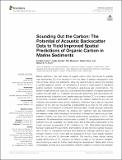Files in this item
Sounding out the carbon : the potential of acoustic backscatter data deliver improved spatial predictions of organic carbon in marine sediments
Item metadata
| dc.contributor.author | Hunt, Corallie Anne | |
| dc.contributor.author | Demsar, Urska | |
| dc.contributor.author | Marchant, Ben | |
| dc.contributor.author | Dove, Dayton | |
| dc.contributor.author | Austin, William | |
| dc.date.accessioned | 2021-11-11T17:30:02Z | |
| dc.date.available | 2021-11-11T17:30:02Z | |
| dc.date.issued | 2021-11-11 | |
| dc.identifier | 276383411 | |
| dc.identifier | 3c5f6310-badd-4415-8ff3-82bf8caf27aa | |
| dc.identifier | 85120433301 | |
| dc.identifier | 000726345800001 | |
| dc.identifier.citation | Hunt , C A , Demsar , U , Marchant , B , Dove , D & Austin , W 2021 , ' Sounding out the carbon : the potential of acoustic backscatter data deliver improved spatial predictions of organic carbon in marine sediments ' , Frontiers in Marine Science , vol. 8 , 756400 . https://doi.org/10.3389/fmars.2021.756400 | en |
| dc.identifier.issn | 2296-7745 | |
| dc.identifier.other | ORCID: /0000-0001-7791-2807/work/103137766 | |
| dc.identifier.other | ORCID: /0000-0002-1955-7277/work/103138111 | |
| dc.identifier.uri | https://hdl.handle.net/10023/24319 | |
| dc.description | Funding: This research was part funded by BGS National Capability funding from the Natural Environment Research Council (NERC), under UK Research and Innovation (UKRI) (Grant Code: Seafloor and Coast - NEE6334S; Digital Labs - NEE75765). CH receives joint funding from the University of St Andrews and the MASTS pooling initiative (The Marine Alliance for Science and Technology for Scotland) for her PhD research, and their support is gratefully acknowledged. MASTS is funded by the Scottish Funding Council (grant reference HR09011) and contributing institutions. Additionally, funding for analyses for this study were supported by a Scottish Government grant for Blue Carbon research. Funds for open access publication fees have been provided by The University of St Andrews. | en |
| dc.description.abstract | Marine sediments hold vast stores of organic carbon. Techniques to map sedimentary organic carbon (SOC) are developing quickly in response to requirements to improve our understanding of carbon (C) cycling, storage, and stock estimates within the marine environment. While the natural burial of C provides a climate regulation service, the disturbance of buried C could be a significant feedback to atmospheric greenhouse gas (GHG) concentrations. We present a regional case study to assess the suitability of integrating archived seafloor acoustic data (i.e., multibeam echosounder bathymetry and backscatter) with physical samples towards improved spatial mapping of surface SOC in a dynamic coastal environment on the east coast of Scotland. Acoustic backscatter is a proxy for seabed sediments and can be collected over extensive areas at high resolutions. Sediment type is also an important predictor of SOC. We thus test the potential of acoustic backscatter as a proxy for SOC. Despite complex interactions between SOC, sediment type and backscatter, we identify significant relationships between these variables. We estimate linear mixed models to predict SOC using backscatter intensity and Folk sediment type as covariates. Our results show that including backscatter in spatial predictions of SOC improves the precision of the model relative to a constant. The backscatter discriminates between coarse and fine sediments; however, it is less able to discriminate amongst the finer sediments. Although Folk sediment type is a stronger predictor of SOC, these data are available at a much lower resolution and do not account for fine-scale variability. The resulting maps thus display varying spatial distributions of SOC reflecting the different scales of the predictor variables. Nevertheless, the predicted standing stocks of SOC from both models are in good agreement with each other and we estimate between 3.0 - 3.1 million tonnes of SOC within surface sediments over the multibeam footprint area of 2,640 km2. Multibeam data as a high-resolution predictor variable in surface SOC mapping studies could help improve our understanding of marine sediments as C stores. Application of such maps have potential in management of the seabed and conservation strategies that consider vulnerable sediment C stores in shelf seas. | |
| dc.format.extent | 11819328 | |
| dc.language.iso | eng | |
| dc.relation.ispartof | Frontiers in Marine Science | en |
| dc.subject | Organic carbon | en |
| dc.subject | Sedimentary carbon | en |
| dc.subject | Multibeam | en |
| dc.subject | Folk classification | en |
| dc.subject | Acoustic backscatter | en |
| dc.subject | Carbon stocks | en |
| dc.subject | Spatial models | en |
| dc.subject | Climate mitigation | en |
| dc.subject | G Geography (General) | en |
| dc.subject | QH301 Biology | en |
| dc.subject | DAS | en |
| dc.subject | SDG 13 - Climate Action | en |
| dc.subject | SDG 14 - Life Below Water | en |
| dc.subject.lcc | G1 | en |
| dc.subject.lcc | QH301 | en |
| dc.title | Sounding out the carbon : the potential of acoustic backscatter data deliver improved spatial predictions of organic carbon in marine sediments | en |
| dc.type | Journal article | en |
| dc.contributor.institution | University of St Andrews. Environmental Change Research Group | en |
| dc.contributor.institution | University of St Andrews. School of Geography & Sustainable Development | en |
| dc.contributor.institution | University of St Andrews. Bell-Edwards Geographic Data Institute | en |
| dc.contributor.institution | University of St Andrews. Coastal Resources Management Group | en |
| dc.contributor.institution | University of St Andrews. Marine Alliance for Science & Technology Scotland | en |
| dc.contributor.institution | University of St Andrews. Scottish Oceans Institute | en |
| dc.contributor.institution | University of St Andrews. St Andrews Sustainability Institute | en |
| dc.identifier.doi | https://doi.org/10.3389/fmars.2021.756400 | |
| dc.description.status | Peer reviewed | en |
This item appears in the following Collection(s)
Items in the St Andrews Research Repository are protected by copyright, with all rights reserved, unless otherwise indicated.

